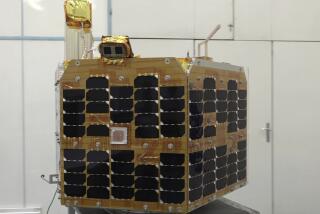United Arab Emirates spacecraft enters orbit around Mars in historic mission

- Share via
DUBAI, United Arab Emirates — A spacecraft from the United Arab Emirates swung into orbit around Mars on Tuesday in a triumph for the Arab world’s first interplanetary mission.
Ground controllers at the UAE’s space center in Dubai rose to their feet and broke into applause when word came that the craft named Amal, the Arabic word for hope, had reached the end of its seven-month, 300-million-mile journey and had begun circling the red planet, where it will gather data on Mars’ atmosphere.
The orbiter fired its main engines for 27 minutes in an intricate, high-stakes maneuver that slowed the craft enough for it to be captured by Mars’ gravity. It took a nail-biting 11 minutes for the signal confirming success to reach Earth.
Tensions were high: Over the years, Mars has been the graveyard for a multitude of missions from various countries.
A visibly relieved Omran Sharaf, the mission’s director, declared, “To the people of the UAE and Arab and Islamic nations, we announce the success of the UAE reaching Mars.”
Two more unmanned spacecraft from the U.S. and China are following close behind, set to arrive at Mars over the next several days. All three missions were launched in July to take advantage of the close alignment of Earth and Mars.
Amal’s arrival puts the UAE in a league of just five space agencies in history that have pulled off a functioning Mars mission. As the country’s first venture beyond Earth’s orbit, the flight is a point of intense pride for the oil-rich nation as it seeks a future in space.
An ebullient Mohammed bin Zayed al Nahyan, the UAE’s day-to-day ruler, was on hand at mission control and said: “Congratulations to the leadership and people of the UAE. ... Your joy is indescribable.”
About 60% of all Mars missions from Earth have ended in failure, crashing, burning up or otherwise falling short in a testament to the complexity of interplanetary travel and the difficulty of making a descent through Mars’ thin atmosphere.
A combination orbiter and lander from China is scheduled to reach the planet on Wednesday. It will circle Mars until the rover separates and attempts to land in May to look for signs of ancient life.
A rover from the U.S. named Perseverance is set to join the crowd next week, aiming for a landing Feb. 18. It will be the first leg in a decadelong U.S.-European project to bring Mars rocks back to Earth to be examined for evidence that the planet once harbored microscopic life.
If it pulls this off, China will become only the second country to land successfully on Mars. The U.S. has done it eight times, the first almost 45 years ago. A NASA rover and lander are still working on the surface.
For months, Amal’s journey had been tracked by the UAE’s state-run media with rapturous enthusiasm. Landmarks across the UAE, including Burj Khalifa, the tallest tower on Earth, glowed red to mark the spacecraft’s anticipated arrival. Billboards depicting Amal tower over Dubai’s highways. This year is the 50th anniversary of the country’s founding, casting even more attention on Amal.
If all goes as planned, Amal over the next two months will settle into an exceptionally high, elliptical orbit of 13,670 miles by 27,340 miles, from which it will survey the planet’s mostly carbon dioxide atmosphere at all times of day and in all seasons.
It joins six spacecraft already operating around Mars: three U.S., two European and one Indian.
More to Read
Sign up for Essential California
The most important California stories and recommendations in your inbox every morning.
You may occasionally receive promotional content from the Los Angeles Times.










